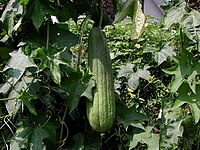| Revision as of 09:51, 1 August 2009 edit222.127.205.156 (talk) →Uses by humans← Previous edit | Revision as of 05:38, 3 August 2009 edit undoMpots19 (talk | contribs)5 edits →Uses by humansNext edit → | ||
| Line 25: | Line 25: | ||
| == Uses by humans== | == Uses by humans== | ||
| Bill O'Rielly sex toy | |||
| The fruit of ''L. aegyptiaca'' may be allowed to mature and used as a bath or kitchen ] after being processed to remove everything but the network of ]. This version is called ''lifah'' in ], ''bholor jaal'' in ], ''dhundul'' in ], ''ghiya tori'' or ''nerua'' in ]. A ''luffa'' or ''loofah'' sponge is used like a body scrub. Both the coarse textured sponge and the soft textured sponge are called ''luffas'' or ''loofahs''. The latter soft textured luffa sponges are not in fact derived from the luffa fruit, but are manufactured by folding in several layers of soft mesh-like fabric into a cloud-like shape; commonly used in tandem with shower gels/lotions. | |||
| Its juice is used as an effective natural remedy for '']''. The juice is obtained by pounding the bitter luffa and squeezing it through a cloth. Bitter luffa seeds and dry crusts are also available and can be used for the same purpose. | |||
| In the Philippines, the Luffa or Patola is eaten as a green vegetable in various dishes. | |||
| == Gallery == | == Gallery == | ||
Revision as of 05:38, 3 August 2009
| This article does not cite any sources. Please help improve this article by adding citations to reliable sources. Unsourced material may be challenged and removed. Find sources: "Luffa" – news · newspapers · books · scholar · JSTOR (May 2008) (Learn how and when to remove this message) |
| Luffa | |
|---|---|

| |
| Egyptian luffa with nearly mature fruit | |
| Scientific classification | |
| Kingdom: | Plantae |
| Division: | Magnoliophyta |
| Class: | Magnoliopsida |
| Order: | Cucurbitales |
| Family: | Cucurbitaceae |
| Genus: | Luffa Mill. |
| Species | |
| |
The luffa, loofah, or lufah (from Arabic لوف) are tropical and subtropical vines comprising the genus Luffa. The fruit of at least two species, Luffa acutangula and Luffa aegyptiaca (Luffa cylindrica), is grown to be harvested before maturity and eaten as a vegetable, popular in Asia and Africa.
The Luffa acutangula is commonly known as ridged gourd and is called 'توری' in Urdu, "bhol" in Assamese, 絲瓜 sigua in Mandarin Chinese, Turai or Tori (तोरी) in Hindi, Jhinga in Bengali, Janhi(ଜନ୍ହି) in Oriya, gisoda or turiya in Gujarati, Beera kaya (బీర కాయ) in Telugu, Heeray kayi in Kannada, peechinga in Malayalam, Dodaka (दोडका) or Ghosavala (घोसावळं) in Marathi, Peerkankaai (பீர்கங்காய்) in Tamil, Wetakolu in Sinhala, Mướp in Vietnamese language, Patola in Tagalog, Kabatiti in Ilocano, and Pitulo in Padang or Minangkabau, Gambas or Oyong in Indonesian language.
Luffa species are used as food plants by the larvae of some Lepidoptera species including Hypercompe albicornis.
Uses by humans
Bill O'Rielly sex toy
Gallery
-
 A bag of natural luffas on an organic farm.
A bag of natural luffas on an organic farm.
-
 Luffa acutangula seeds. Each division of the ruler is 1 mm. Seeds of Luffa aegyptica look very similar.
Luffa acutangula seeds. Each division of the ruler is 1 mm. Seeds of Luffa aegyptica look very similar.
-
 A luffa sponge whose coarse texture helps with skin polishing.
A luffa sponge whose coarse texture helps with skin polishing.

See also
External links
- Multilingual taxonomic information at the University of Melbourne
- Luffa aegyptiaca at Floridata
- Luffa Information
This fruit-related article is a stub. You can help Misplaced Pages by expanding it. |